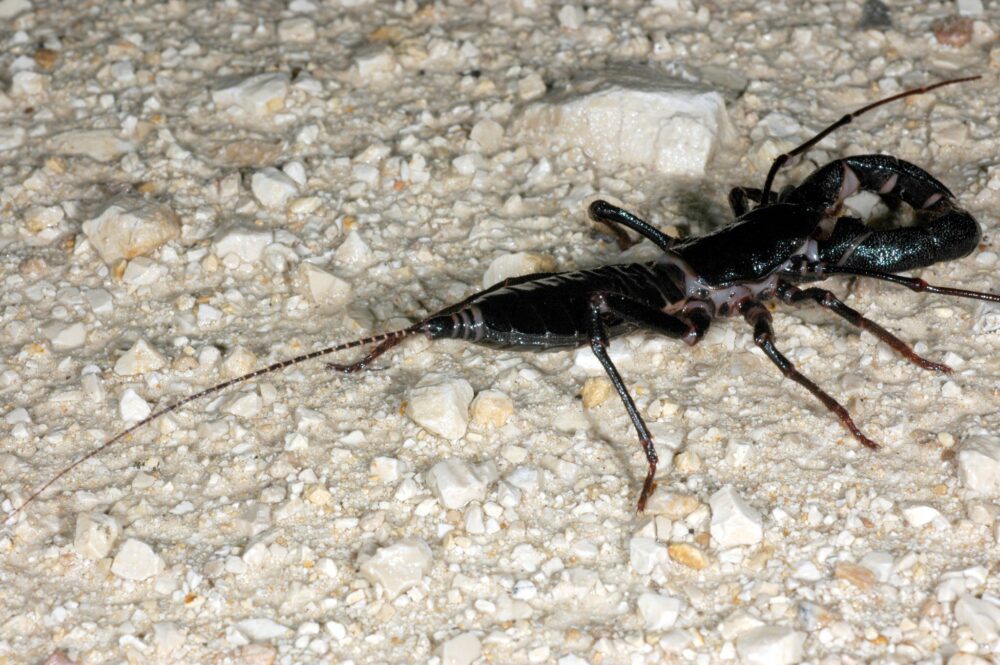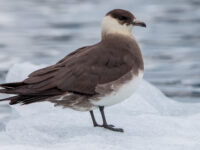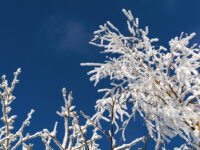Subzero temperatures. Eighty mile per hour wind gusts. Nineteen hours of darkness each day. It’s hard to believe that anything could survive the brutal winters of Anvers Island, but hidden under the snow, a hardy insect weathers it all. The Antarctic midge, Belgica antarctica, lives farther south than any other insect in the world. At a humble three millimeters long, it is the largest terrestrial animal native to Antarctica.
The Antarctic midge spends most of its life cycle in the larval stage. The larvae reside underground, where they are protected from the harshest Antarctic temperatures by layers of insulating snow and ice. After nearly two years living in the subnivean zone, the habitat under the snow, the larvae form pupae and begin their metamorphosis. Fully grown midges emerge shortly after, already nearing the end of their lives; the tiny, flightless adults mate, lay eggs, and die within 10 days. Several weeks later, the eggs hatch and a new generation of larvae prepare to sit through the brutal winter. In order to survive, the larvae utilize a collection of adaptations that have been honed by millions of years of evolution in this uniquely harsh habitat.
At a humble three millimeters long, it is the largest terrestrial animal native to Antarctica.
Like other freeze tolerant insects, B. antarctica has evolved methods to carefully control the formation of ice within its body, preventing damage to cells. Larvae produce ice nucleating agents, molecules that promote the formation of ice crystals at relatively high temperatures and thus initiate the freezing of bodily fluids at warmer temperatures. This causes ice to form more gradually and reduces the risk of cellular damage. Additionally, ice nucleating agents are primarily found in the hemolymph, insects’ equivalent of blood. This means that ice formation mainly occurs in the hemolymph, rather than within cells, further preventing damage.
Animals that live in cold environments generally rely on one of two strategies to survive the extreme conditions. They are either freeze tolerant, meaning they can survive the formation of ice within their bodies, or they are freeze resistant, which means that they can prevent internal ice formation, even when their body temperature is below freezing temperature. The larvae of the Antarctic midge have the extraordinary ability to employ either of these strategies.
Despite the protective actions of ice nucleating agents, freeze tolerance has its drawbacks. Repetitive internal freezing and thawing can cause mechanical damage to the body and disrupt homeostasis. Under some circumstances, Antarctic midge larvae can prevent these consequences by resisting freezing through a process called cry preservative dehydration. To undergo cry preservative dehydration, larvae produce molecules that lower the freezing point of their bodily fluid. The supercooled fluid within the larvae’s body then has a lower vapor pressure than the ice in the soil surrounding its body. This causes the body to lose water until the vapor pressure inside and outside of the body is the same. As water is lost, the freezing point of the larvae’s bodily fluid drops until it reaches the temperature of the surrounding environment, at which point the fluid is not at risk of freezing. B. antarctica’s unique ability to exhibit either freeze tolerance or cry preservative dehydration contributes to its incredible resilience in extreme weather.
B. antarctica’s unique ability to exhibit either freeze tolerance or cry preservative dehydration contributes to its incredible resilience in extreme weather.
The Antarctic midge must be capable of surviving a wide range of temperatures, not just the cold. While the larvae’s subnivean microhabitat typically sits between -7 and -2 degrees Celsius in the winter, temperatures can reach as high as 15 degrees Celsius in the summer. But even during the warmest periods of the year, the temperature can abruptly drop below zero. To handle the unpredictable conditions, B. antarctica uses an array of adaptations that allow for survival in both cold and warmer temperatures. Among these are genes that allow for freeze tolerance and genes that code for heat shock proteins, molecules which prevent heat-related damage. These types of adaptations are not uncommon among organisms living in extreme conditions. However, most animals turn these genes on and off, expressing them only when they are specifically needed due to environmental stress. B. antarctica larvae, on the other hand, constantly express the genes responsible for freeze tolerance and heat tolerance. This preemptive expression allows the larvae to endure the sudden, dramatic changes in the environmental conditions of the Antarctic.
Understanding organisms like the Antarctic midge is becoming increasingly important as Earth is ravaged by climate change. As the planet continues to warm, more regions are seeing unpredictable shifts in temperature and weather like those that B. antarctica endures in the Antarctic. Studying creatures that live in extreme habitats can inform us of strategies that allow for survival in these habitats — strategies that more and more organisms will need to utilize in order to survive a changing world.
The Biological Bulletin (2021). DOI: 10.1086/BBLv229n1p47
British Ecological Society (2013). DOI: 10.1111/1365-2435.12229
Journal of Experimental Biology (2008). DOI: 10.1242/jeb.011874
PNAS (2006). DOI: 10.1073/pnas.0606840103




